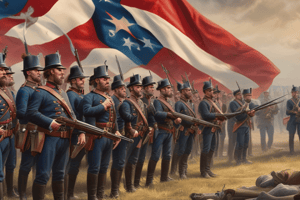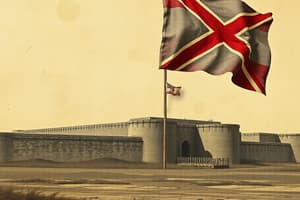Podcast
Questions and Answers
Which battle is recognized as the first ironclad battle?
Which battle is recognized as the first ironclad battle?
- Battle of Antietam
- Battle of Bull Run
- Battle of Gettysburg
- Battle of Hampton Roads (correct)
The Emancipation Proclamation was issued in September 1861.
The Emancipation Proclamation was issued in September 1861.
False (B)
Who was the commander of the Army of Northern Virginia?
Who was the commander of the Army of Northern Virginia?
Robert E. Lee
The __________ was a submarine used by the Confederacy that sank the USS Housatonic.
The __________ was a submarine used by the Confederacy that sank the USS Housatonic.
Match the following events with their corresponding dates:
Match the following events with their corresponding dates:
What was a key advantage of the Confederacy during the Civil War?
What was a key advantage of the Confederacy during the Civil War?
The Union had a moral position after 1862 that revolved around the destruction of slavery.
The Union had a moral position after 1862 that revolved around the destruction of slavery.
How many total men were available for service in the Union?
How many total men were available for service in the Union?
The Confederacy used the __________ Act to mandate military service among males aged 18-35.
The Confederacy used the __________ Act to mandate military service among males aged 18-35.
Match the following groups to their respective advantages during the Civil War:
Match the following groups to their respective advantages during the Civil War:
Which of the following best describes the economic impact on the Confederacy during the Civil War?
Which of the following best describes the economic impact on the Confederacy during the Civil War?
The Union had a wealth advantage in War Bonds compared to the Confederacy.
The Union had a wealth advantage in War Bonds compared to the Confederacy.
Name one new occupation that emerged for women during the Civil War.
Name one new occupation that emerged for women during the Civil War.
Flashcards
Ironclads
Ironclads
Iron-plated warships, like the CSS Virginia (Confederacy) and Monitor (Union), introduced a new era of naval warfare.
Battle of Hampton Roads
Battle of Hampton Roads
A battle where two ironclad ships engaged, the CSS Virginia and the Monitor, ending in a stalemate, marking the first ironclad battle.
Trench Warfare
Trench Warfare
A type of warfare where troops fight from trenches, providing protection against the accuracy and range of rifles.
Emancipation Proclamation
Emancipation Proclamation
Signup and view all the flashcards
Peninsula Campaign
Peninsula Campaign
Signup and view all the flashcards
Confederate Advantages
Confederate Advantages
Signup and view all the flashcards
Union Population and Industrial Advantages
Union Population and Industrial Advantages
Signup and view all the flashcards
Union Moral Advantage after 1862
Union Moral Advantage after 1862
Signup and view all the flashcards
Union Manpower Advantage
Union Manpower Advantage
Signup and view all the flashcards
Union Weaponry Advantage
Union Weaponry Advantage
Signup and view all the flashcards
Anaconda Plan
Anaconda Plan
Signup and view all the flashcards
Telegraph in the Civil War
Telegraph in the Civil War
Signup and view all the flashcards
Railroad in the Civil War
Railroad in the Civil War
Signup and view all the flashcards
Study Notes
Confederate Advantages
- Home field advantage: fighting on familiar territory
- Knowledge of the land: confederates were familiar with the terrain
- High morale: fighting to defend their homes and families
Union Advantages
- Larger population: 2.5 times more people than the Confederacy
- 1/3 of Confederate population were enslaved and thus not available to fight
- Strong industrial capacity: 90% of US industrial capacity located in the North
- More resources: the North had more guns, clothing and other supplies
- Railroads: control of most railroads
- Strengthened moral position: the Emancipation Proclamation shifted the war focus to destroying slavery
Resources (Manpower)
- Union: 22 million people
- Confederacy: 6 million people (1/3 were enslaved)
- Confederacy implemented conscription in 1862
- Men aged 18-35 (later 17-50) were required to serve for 3 years
- Exemptions allowed; hiring replacements or claiming ownership of 20 enslaved people
- Union implemented conscription in 1863
- Men aged 20-45 were eligible for service
- Exemptions were granted; paying a fee ($300) or hiring replacements
Weaponry
- Union had an advantage in manufacturing weapons
- Confederacy relied on European imports and domestic production
Food/Clothing/Shoes
- Confederacy faced shortages
Economy
- Union had more varied population and markets, less reliant on foreign trade
- Confederacy's economy relied on cotton trade, which was disrupted by the Union blockade
- War bonds issued by both sides
- Taxes collected by both sides
- Inflation resulted from the printing of money
- Union: $431,000,000
- Confederacy: $1,500,000,000
- Union economy prospered, while Confederate economy suffered
Women in the War
- Worked on home farms and ran other businesses
- Involved in government work (bureaucracy, spies, smuggling)
- Became nurses (3,200 served in the war)
- Notable figures include Dorothea Dix, and Clara Barton
- Significant roles in education
Technology of the Civil War
- Telegraph used to communicate intelligence and track troops
- Railroads used for moving troops and supplies
- Naval advances included:
- Union blockade of Southern coastline to control the Mississippi River
- Iron-plated warships (CSS Virginia and Monitor)
- Battle of Hampton Roads (March 9, 1862): first ironclad battle
- Submarines (e.g., Hunley)
Rifles and Guns
- Rifles and repeating rifles of 1850 had longer range and greater accuracy
- Machine guns were not yet widely used
Trench Warfare
- Defensive warfare used for rifle fire protection
The War: Phase I (1861-1862)
- Leadership: Early struggles for Union in finding effective generals (George B. McClellan)
- Confederacy leadership Strong leadership under Robert E. Lee
- Border States: Missouri, Kentucky, Maryland, Delaware were kept in the Union by Lincoln, avoiding widespread division
- Expectations: Short conflict anticipated by both sides, initially.
- First Battle of Bull Run (1861): Led to initial Confederate victory.
- Theaters of War: Western and Eastern theaters
- Campaigns (1861-1862): Union objectives included destroying the Army of Northern Virginia and capturing Richmond (Confederate capital)
- Peninsula Campaign (1862): McClellan's plan to capture Richmond, but stalled due to Lee's adept leadership.
- Lee's Invasion of Maryland (1862): Confederate initiative aimed at gaining supplies and threatening Washington, though resulted in a strategic Union victory at the Battle of Antietam
Emancipation Proclamation
- A military decision designed to weaken the Confederacy by freeing slaves in the Confederacy
- Changed the nature of the war
- Prevented European alliance with the Confederacy
Studying That Suits You
Use AI to generate personalized quizzes and flashcards to suit your learning preferences.




